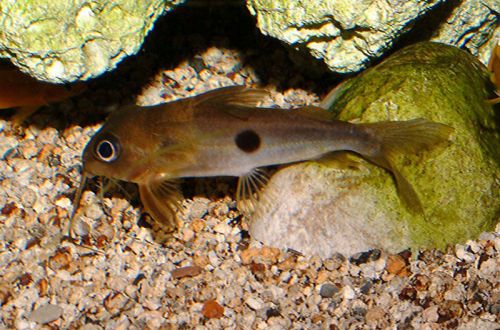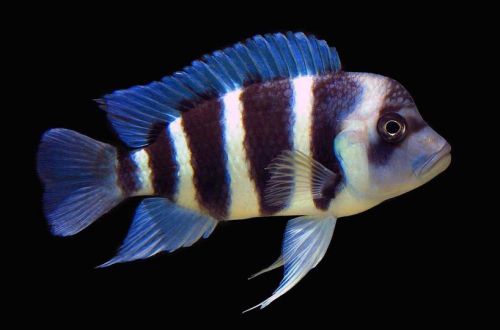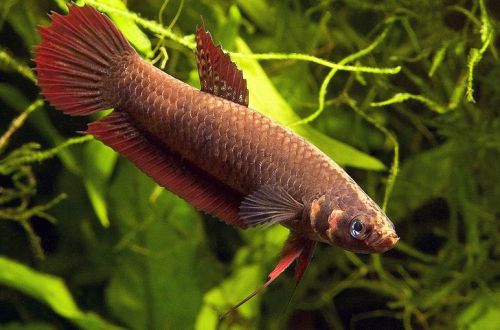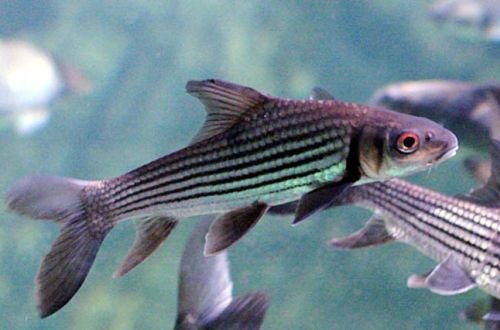
Synodontis-domino
Domino Synodontis or Single Spot Synodont, scientific name Synodontis notatus, belongs to the Mochokidae family. Although one of the names contains the word “single-point”, the number of round spots in the pattern can reach 6. It is unpretentious and easy to maintain, compatible with many other fish species, but does not get along well with its relatives. In an amateur aquarium, it is recommended to keep only one catfish.

Contents
Habitat
It is widely distributed throughout the Congo Basin in the territory of the modern states of the Democratic Republic of the Congo and the Republic of the Congo. Occurs in various biotopes, prefers regions with a slow current, backwaters with a lot of shelters.
Brief information:
- The volume of the aquarium – from 150 liters.
- Temperature – 22-25°C
- Value pH — 6.5–7.5
- Water hardness – soft to medium hard (8-18 dGH)
- Substrate type – sandy, soft
- Lighting – subdued or moderate
- Brackish water – no
- Water movement – light or moderate
- The size of the fish is up to 27 cm.
- Nutrition – any drowning
- Temperament – conditionally peaceful
- Content single
Description
Adult individuals reach a length of about 27 cm. The color is gray, a characteristic feature in the pattern is the presence of large round dots, their number may vary, but usually no more than three. This feature is reflected in the name of this species – Synodontis-domino or Somik-Domino. Sexual dimorphism is weakly expressed, it is rather problematic to distinguish a male from a female.
Food
It is considered omnivorous and unpretentious, accepts all types of food – dry, frozen, live and vegetable, including vegetables, such as peeled peas, cucumbers, spinach. A varied diet has a positive effect on the tone of the fish and minimizes the risk of digestive problems. It is noted that low-quality dry food may not have the best effect on the health of catfish.
Maintenance and care, arrangement of the aquarium
The optimal tank size for one fish starts from 150 liters. The design uses a soft sandy substrate, pieces of snags and roots that form shelters, fragments of rocks and rocks. The presence of aquatic plants is helpful, but not required. For example, plants floating on the surface can serve as an additional means of shading, since Synodontis domino prefers a subdued level of illumination, however, even with moderate light in a common aquarium, it will not experience discomfort.
A wide habitat has led to adaptation to wide values of the hydrochemical composition of water, so there will be no problems with water treatment when maintaining and cleaning the aquarium. Despite its unpretentiousness, you should regularly clean the soil from organic waste and replace part of the water with fresh water.
Behavior and Compatibility
Conditionally peaceful look, combined with many fish, with the exception of very small ones, which can become an occasional dinner for such a large catfish. This is not a sign of aggression, but the usual promiscuity in food, inherent in most catfish. Intraspecific relationships are also not simple. Adult fish are very territorial and will engage in serious skirmishes if the aquarium is not large enough and/or there are not enough hiding places.
Breeding / breeding
They are very reluctant to spawn in home aquariums, so there is practically no reliable information about breeding in artificial conditions. In commercial projects, breeding is carried out, due to which Synodontis caught from the wild have practically disappeared from the sale.
Fish diseases
The main cause of most diseases is unsuitable living conditions and poor-quality food. If the first symptoms are detected, you should check the water parameters and the presence of high concentrations of hazardous substances (ammonia, nitrites, nitrates, etc.), if necessary, bring the indicators back to normal and only then proceed with treatment. Read more about symptoms and treatments in the Aquarium Fish Diseases section.





